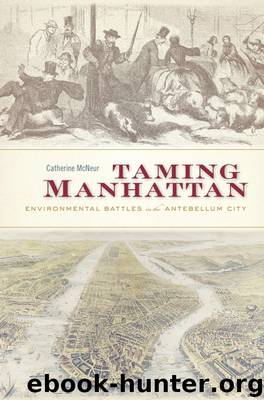Taming Manhattan : Environmental Battles in the Antebellum City (9780674745148) by Mcneur Catherine

Author:Mcneur, Catherine
Language: eng
Format: epub
ISBN: 9780674725096
Publisher: Harvard Univ Pr
FIGURE 24. Hauling the Pigs Out from Under the Beds. Leslie and other journalists poked fun at Irish domesticity when they showed how closely the immigrants lived with livestock. From Frank Leslie’s Illustrated Newspaper, August 13, 1859. (Sterling Memorial Library, Yale University.)
Women actually played the most violent role in resisting the police. Perhaps because the officers were less likely to treat a female attack seriously or to assault a woman, the piggery owners’ wives chose to take up clubs and other weapons and defend their property. In one case, after a policeman seized a hog by the ears, he was confronted by a “large squarely built German woman” with an enormous tin pot. She whacked the officer with the pot “in a way that made him see stars.” The New York Herald reporter described what he saw as a comic encounter: “The battle field at this moment presented a thrilling scene, and the spouting of the German, the screams of his frau, the banging of the tin kettle, the shouts of the beleaguered official for aid, and the shrill squealing of the captured porker, struggling to free his tail from the vice-like grasp which held it, altogether sent a combination of sounds which could hardly have been surpassed on any battle field in Italy.” Aside from the occasional female assault on a police officer, the only other reported act of rebellion occurred at the pound. After the first night of hog collecting, some of the male owners broke into the temporary pound on 50th Street and drove the squealing fugitives back to their pens. Police quickly located the hogs, however, and took them into custody again. These attempts at resistance did little to prevent or even stall the Piggery War.55
The city seemed to have gained the upper hand. During the earlier hog riots of the 1820s and 1830s the municipal government had been fairly weak, but now it held far more control of the urban environment in terms of both public and private space. The absence of a riot surprised the media and the police. Perhaps the large number of heavily armed police and inspectors kept resistance at bay. Such strict enforcement of public health laws was rare, and the owners were likely unprepared for the city’s committed response. Police power was a novelty in the city during this era.
The tables had certainly turned. In 1857, two years prior to the Piggery War, the New York State legislature passed the Metropolitan Police Act. Funded largely by the counties and under the governance of state-appointed commissioners, it combined the forces of New York, Kings, Richmond, and Westchester counties. The act declared that the Metropolitan Police were responsible for enforcing all of the city’s laws, an issue the city had struggled with for decades, as was evident from the hog and dog riots, public health violations, and the city’s uneven control of public space. Challenged unsuccessfully by Mayor Fernando Wood, the Metropolitan Police were a part of the state legislature’s attempt to take charge of the unruly city and its corrupt politicians.
Download
This site does not store any files on its server. We only index and link to content provided by other sites. Please contact the content providers to delete copyright contents if any and email us, we'll remove relevant links or contents immediately.
Kathy Andrews Collection by Kathy Andrews(10509)
The remains of the day by Kazuo Ishiguro(7543)
Spare by Prince Harry The Duke of Sussex(4188)
Paper Towns by Green John(4165)
The Body: A Guide for Occupants by Bill Bryson(3791)
Be in a Treehouse by Pete Nelson(3206)
Harry Potter and the Goblet Of Fire by J.K. Rowling(3025)
Goodbye Paradise(2950)
Never by Ken Follett(2873)
Into Thin Air by Jon Krakauer(2695)
The Remains of the Day by Kazuo Ishiguro(2614)
The Genius of Japanese Carpentry by Azby Brown(2602)
The Cellar by Natasha Preston(2592)
Drawing Shortcuts: Developing Quick Drawing Skills Using Today's Technology by Leggitt Jim(2529)
120 Days of Sodom by Marquis de Sade(2428)
Architecture 101 by Nicole Bridge(2348)
The Man Who Died Twice by Richard Osman(2290)
Machine Learning at Scale with H2O by Gregory Keys | David Whiting(2267)
Fairy Tale by Stephen King(2059)
